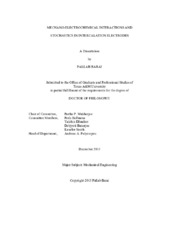| dc.description.abstract | Lithium ion battery (LIB) is replacing all the other battery chemistries from the portable electronic and automotive market due to its superior energy and power density. During operation, transport of lithium atoms within the active particles through diffusion process induces large amount of diffusion induced stress (DIS). A computational methodology has been developed that is capable of estimating the concentration gradient, subsequent DIS and formation of microcracks within graphite active particles. Nucleation of these microcracks form large spanning cracks, which not only impedes the transport of lithium within the solid phase but also acts as fresh sites for the formation of solid electrolyte interface (SEI). Active particles of smaller size (<5μm) and operation at lower rates experiences negligible capacity fade due to microcrack formation. Damage evolution in brittle media occurs initially in a random fashion and towards the end localized propagation is observed. Grain/grain-boundary microstructures with smaller grain sizes display higher strength against crack propagation.
By solving the dynamic momentum balance equation, the acoustic emission spectra and jump in energy release rate (avalanche), observed in experiments can be predicted. Since only brittle crack propagation is being considered, evolution of mechanical damage happens in the first three cycles, and then saturates. A reduced order model (ROM) has been developed that can predict the amount of mechanical degradation as a function of particle size and rate of operation. A pseudo 2D computational methodology has been demonstrated that can predict the increase in mass transport resistance and performance decay in lithium ion batteries due to mechanical degradation. Under drive cycle operation, it is safe to use anode particles of radius smaller than 10μm from the capacity fade perspective. Transport of lithium inside high capacity anode materials (such as, Si, Sn) occurs through two phase diffusion process. This gives rise to DIS and fracture at the two phase interface and the particle surface due to high volume expansion. Usage of functionally graded Si with reduced elastic modulus close to the surface is capable of minimizing the microcrack formation. Creep deformation can be significant in Sn active particles during operation at low rates. | en |


